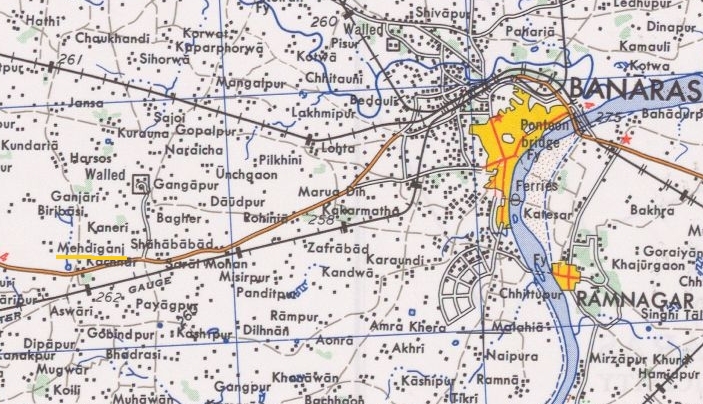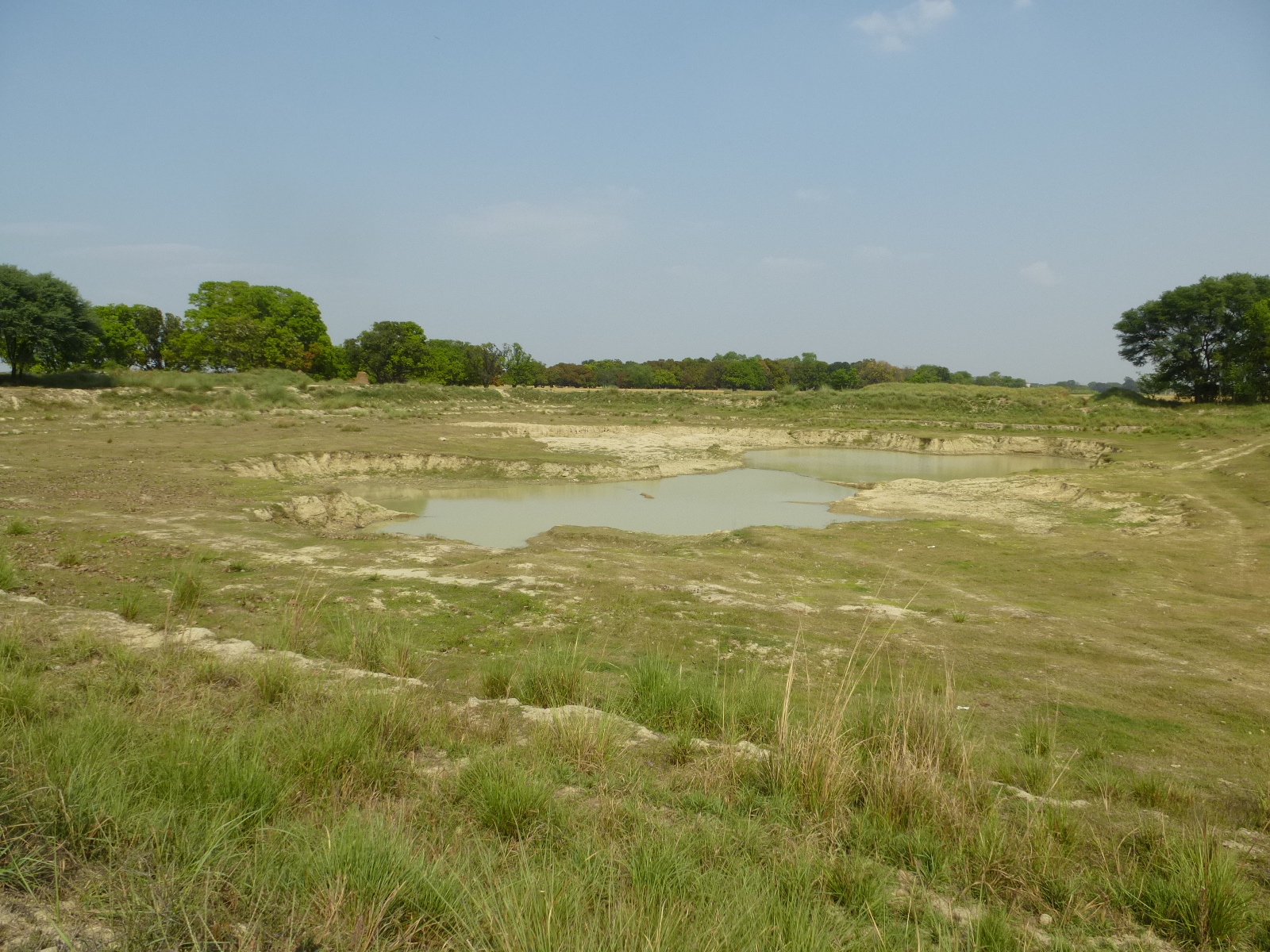Bottled drinks are commonplace and we often reach for them without a thought. We may even feel good about our purchase as we read about the companies' commitment to water security' printed on the label.
What does 'being water positive' really mean for the villages where manufacturing plants are situated ? This article examines the case of one such plant in Mehdiganj, PO Benipur, Arajiline block, Dist Varanasi and its effect on the groundwater levels in the area. The village has led an agitation against 4 specific negative impacts of the plant, acheiving moderate but measurable success.
This year, the movement comes to a crisis point as despite a warning by the Central Groundwater Development Board, the plant applies for a four-fold expansion.

Excerpt of map showing Varanasi and Mehdiganj
The area:
Mehdiganj is a small village just off the Grand Trunk Road, a few kilometers from Varanasi. Benipur, of which it forms a part, had a population of less than 11000 persons in 2001. The primary occupation is agriculture with the predominant crop being wheat. In addition to the wheat, some farmers grow vegetables. While horticulture is not an expanding business, the village is known for the mangoes it produces.
The background:
Since Hindustan Coca-Cola Beverages Private Limited (HCCBPL) set up its plant in 2000, the villagers claim it has defrauded them in four crucial areas:
- Excessive withdrawal of groundwater leading to its depletion
- Disposal of sludge and wastewater
- Encroachment of land and evasion of stamp duty
- Ignoring labour laws and other harassment of the residents
A complete narrative of the struggle can be obtained here. Also read the account on Lok Samiti's site here.
The present crisis:
In 2009, Arajiline block was declared 'critical' in by the Central Groundwater Board. Despite that, in February 2012, HCCBPL applied for a NOC to expand its operations.

HCCBPL's application for increasing withdrawal by 200,000 cum per annum in a critical area
(Please download the letter using the links provided below this article)
This expansion will increase withdrawal to a 250,000 cubic metres per annum from the original 50,000 cubic metres - an increase of 4 times over the present consumption. This will have disastrous impacts on the farmers in the surrounding area. The groundwater in the area is dropping at the rate of more than 1 m per year. It is now at about 13.5m below ground level from just 3.5 m in 2002. The area is already exploited to 96.39% of its total capacity. The deeper the water table, the more energy farmers need to expend to irrigate their fields. A point will soon come when farmers can no longer afford to pump water out, whereas HCCBPL has the economic means to drill further. A lack of irrigation will affect the quality and yield of their market-bound vegetables.
The fallacy of water-positive manufacturing
Several bottled water companies including HCCBPL promote their water conservation efforts. In this case, Coca-Cola claims that it is recharging 120% the quantity of the water that it sucks out of the aquifer. The numbers are arrived at not on the basis of empirically rigorous measurement, but on the basis of generous thumb-rule estimations.
HCCBPL has constructed several rooftop rainwater harvesting units. It arrives at the quantity of water being harvested by multiplying the rainfall considered 'normal' for the area with the square metres that drain into each unit. However, the area has not received 'normal' rainfall for all but two years since 2004. The inefficacy of the rainwater harvesting structures have been confirmed by both CGWB and HCCBPL.
Several of these rainwater harvesting units are neither in the immediate vicinity of the plant, nor in the 10km radius buffer zone, but in government buildings upto 30km away. If there are any benefits, they need to be considered at a 'global' scale, because the farmers certainly do not benefit from these.
Similarly, HCCBPL is proposing to compensate for its expansion by rainwater harvesting. This is proposed to be done by converting existing village tanks into percolation tanks by excavating the deposited clay layer that acts as a water holding strata. While this may theoretically benefit some wells, it will definitely have a negative impact on lift irrigation from the tanks, as they will no longer hold water. This will further increase farmers' costs by forcing them to expend more energy in lifting water. It also needs to be mentioned here that regular desilting and maintenance is carried out in these tanks by the Panchayats through MGNREGA. However, this has not stopped HCCBPL from claiming credit- and groundwater- by a proposed deepening of these village tanks.

The tank at Mehdiganj in April 2013
The response:
Lok Samiti is gearing up to meet this crisis by sourcing all the information they can, relentlessly keeping on top of any progress in the application, and writing letters to government officials. You can download the letter they are forwarding to various government agencies below. It provides a succint and convincing testament to the importance of not increasing groundwater withdrawals in the area.
The activists:

Their address:
Lok Samiti
Nagepur
PO Benipur, Dist. Varanasi, UP 221 307
E-mail: loksamiti@gmail.com
And now it's your turn:
The gap between the origins of our food and our awareness of where it comes from, is increasing daily. Very often, a wilful blindness seems to be the norm. I am referring to an increasing tendency to ignore the more squeamish reality of our food. It is this tendency that is giving rise to concerned news articles, blog posts, and books.
While it is most apparent when we order a meat dish prepared boneless with the specific intent that it will not remind us of where it came from, it also applies to soft drinks. We ignore as we drink 'just one bottle' of a fizzy drink that this was produced in a factory along with millions of others, to satisfy the craving of a million individuals who are each drinking 'just one bottle'.
Bottled drinks in their many forms are an ubiquitous part of our lives today. The real cost of these drinks, as we have seen in this article, is far more than the Rs 30/- we pull out of our wallets. The real cost is paid by entities that do not even figure in our everyday transactions- the environment, our global 'trust fund' of fossil aquifers, and the people living near the plants where bottled drinks are produced. This case study refers to Coca-Cola, but the issue is true for all purveyors of bottled water no matter how 'water-positive' they claim to be.
But let us stick to the issue of Mehdiganj. They are at a crisis now. Despite the authenticity of their concerns, despite the reams of data that they have backing their claims, they may still not be heard. Despite their courage, Goliath might still defeat them.
What can you do to ensure Mehdiganj is not deprived any further of its water ?
/articles/story-how-blissful-ignorance-allows-hindustan-coca-cola-beverages-deprive-mehdiganj